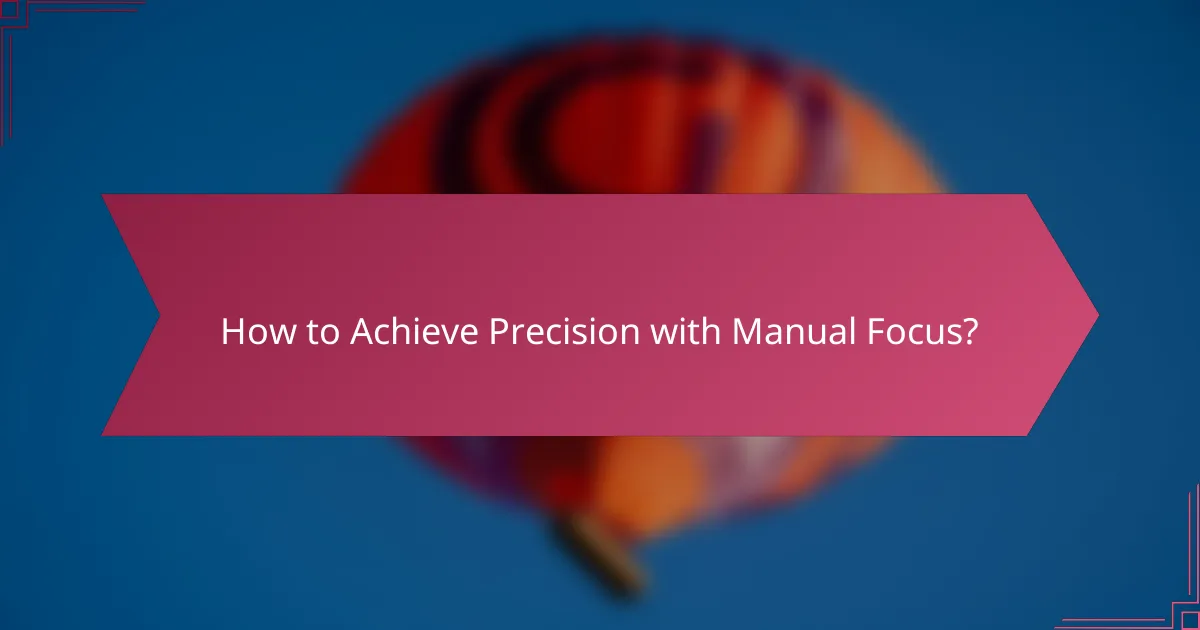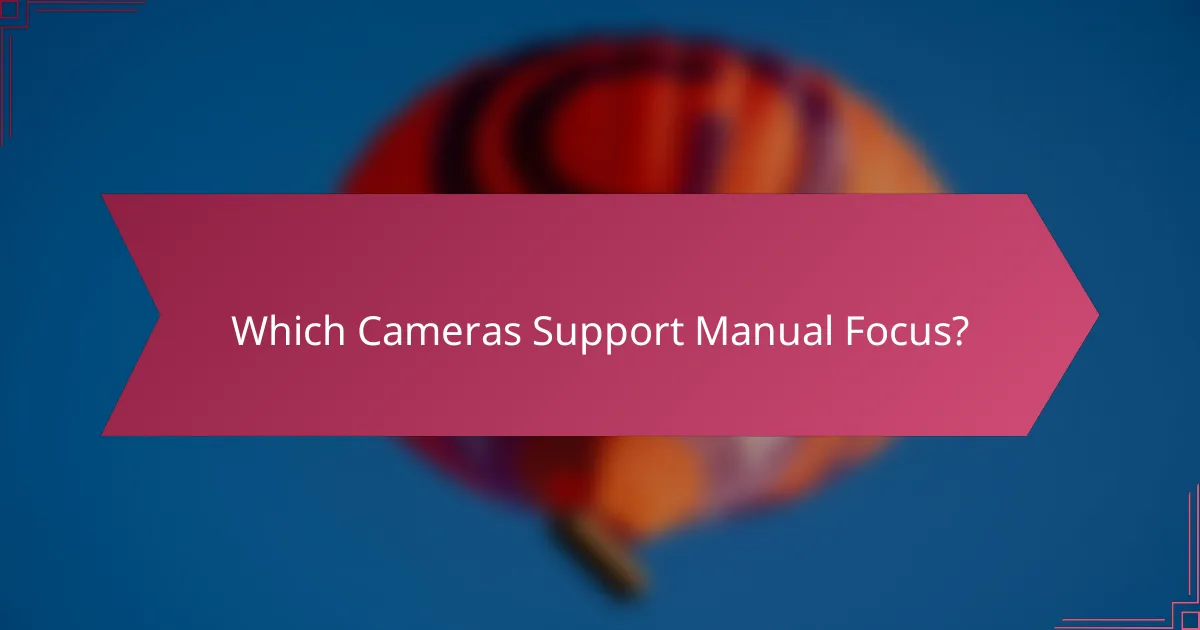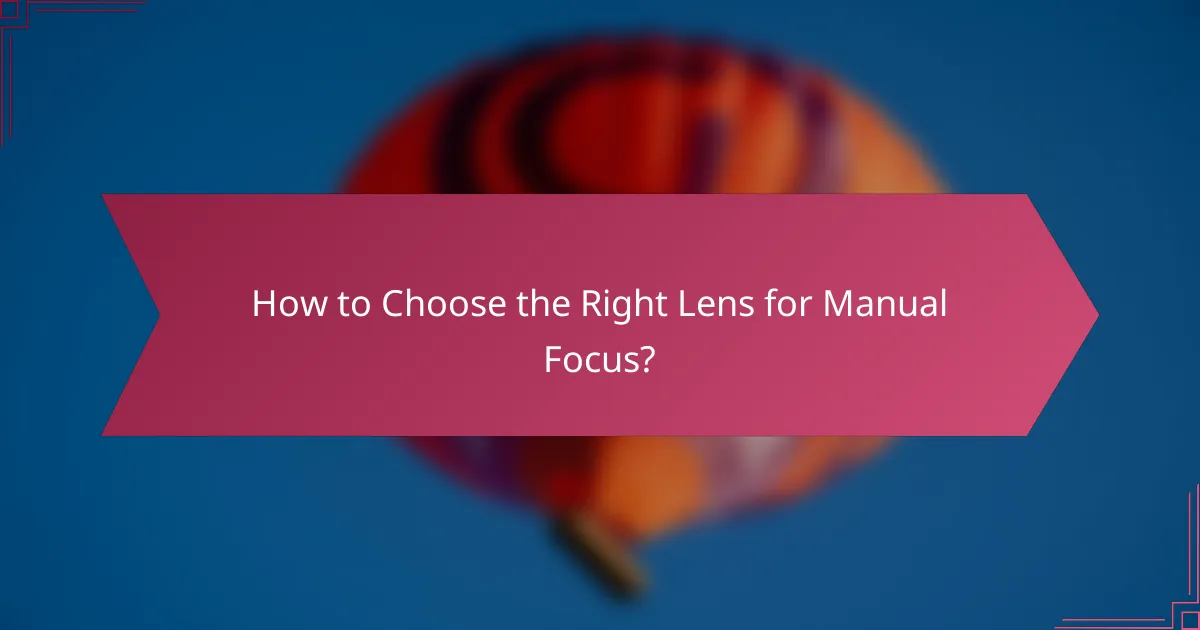Manual focus empowers photographers and videographers with enhanced precision and control, enabling them to craft images with intentional framing and depth of field. By mastering this technique, you can achieve sharp, cinematic-quality visuals that elevate your storytelling. Many modern cameras, particularly mirrorless and DSLRs, support manual focus, providing the tools necessary for precise adjustments in various shooting conditions.

How to Achieve Precision with Manual Focus?
Achieving precision with manual focus involves careful adjustments and techniques that enhance control over your camera’s focus. By mastering specific tools and methods, you can create sharp images with a cinematic quality.
Use of focus peaking
Focus peaking highlights the areas of your image that are in sharp focus, making it easier to achieve precision. This feature is particularly useful in low-light situations or when using wide apertures, as it visually indicates which parts of the scene are sharp.
To utilize focus peaking effectively, adjust the sensitivity settings on your camera to suit your shooting environment. A higher sensitivity can help in complex scenes, while lower settings may be more appropriate for simpler compositions.
Adjusting aperture settings
Adjusting your aperture settings is crucial for achieving the desired depth of field and focus precision. A wider aperture (like f/1.8) allows more light and creates a shallow depth of field, which is ideal for isolating subjects.
Conversely, a smaller aperture (like f/8 or f/11) increases depth of field, making more of the scene sharp. Experiment with different apertures to find the right balance for your composition and lighting conditions.
Utilizing depth of field
Understanding depth of field is essential for precise manual focus. Depth of field refers to the range of distance within a photo that appears acceptably sharp. By controlling this range, you can direct the viewer’s attention to specific elements in your image.
To achieve the desired depth of field, consider the distance from your subject, the focal length of your lens, and your aperture setting. For instance, using a longer focal length or a wider aperture will yield a shallower depth of field.
Employing focus assist tools
Focus assist tools, such as magnification and electronic viewfinders, can significantly enhance your manual focusing accuracy. Magnification allows you to zoom in on your subject in the viewfinder or on-screen, ensuring precise focus on critical areas.
Many cameras also offer electronic viewfinders that provide real-time feedback on focus accuracy, which can be invaluable in challenging lighting conditions. Familiarize yourself with these tools to improve your focusing skills.
Practicing with different lenses
Practicing with various lenses can help you understand how each lens behaves with manual focus. Different focal lengths and designs can affect depth of field and focus precision, so experimenting will enhance your skills.
Try using prime lenses for their sharpness and clarity, or zoom lenses for versatility. Each lens will offer unique characteristics that can influence your approach to manual focus, allowing you to adapt your technique accordingly.

What Are the Benefits of Manual Focus?
Manual focus offers photographers and videographers greater precision and control over their shots, allowing for more intentional framing and depth of field. This technique can significantly enhance the overall quality and creativity of visual storytelling.
Enhanced creative control
Using manual focus empowers creators to make deliberate choices about what elements are in sharp focus and which are blurred. This control allows for artistic expression, enabling unique compositions that draw attention to specific subjects or details.
For instance, a photographer can emphasize a flower in a garden by focusing solely on it while softening the background. This technique can transform an ordinary scene into a captivating visual narrative.
Improved focus accuracy
Manual focus provides a higher level of accuracy compared to autofocus, especially in complex scenes where autofocus may struggle. By manually adjusting the focus ring, users can ensure that the intended subject is perfectly sharp, avoiding the frustration of missed focus.
In situations with low contrast or intricate patterns, manual focus can be particularly beneficial. Photographers often find that taking the time to adjust focus manually leads to more satisfying results.
Ability to create cinematic effects
Manual focus is essential for achieving cinematic effects such as rack focus, where the focus shifts from one subject to another within a shot. This technique adds a dynamic quality to videos, guiding the viewer’s attention and enhancing storytelling.
For example, in a scene where a character is speaking, the focus can shift to an object in the background, creating a deeper narrative layer. This effect is commonly used in film and can be easily accomplished with manual focus.
Better performance in low light
In low-light conditions, manual focus often outperforms autofocus systems, which may struggle to find the correct focus point. By manually adjusting the focus, users can achieve sharp images even in challenging lighting situations.
When shooting in dim environments, using techniques like focus peaking can assist in ensuring accuracy. This method highlights the areas in focus, making it easier to achieve the desired sharpness without relying on autofocus.

Which Cameras Support Manual Focus?
Many modern cameras support manual focus, allowing photographers to have greater control over their shots. This feature is commonly found in mirrorless and DSLR cameras, enabling precise adjustments for different shooting conditions.
Canon EOS R series
The Canon EOS R series includes several models that excel in manual focus capabilities, such as the EOS R5 and EOS R6. These cameras feature a focus peaking function, which highlights the in-focus areas, making it easier to achieve sharp images.
Additionally, the RF lens lineup provides excellent compatibility with manual focus, allowing for smooth adjustments. Photographers can benefit from the customizable control rings on RF lenses, enhancing the manual focusing experience.
Nikon Z series
Nikon’s Z series, including the Z6 and Z7, offers robust manual focus options. The cameras come equipped with focus peaking and a high-resolution electronic viewfinder, which aids in achieving precise focus. This is particularly useful for macro photography or low-light situations.
The Z series lenses are designed to work seamlessly with manual focus, providing a tactile experience that many photographers appreciate. Users should take advantage of the customizable settings to optimize their manual focus workflow.
Sony Alpha series
The Sony Alpha series, such as the A7 III and A7R IV, supports manual focus with advanced features like focus magnification and peaking. These tools help users fine-tune their focus, especially in challenging lighting or when shooting at wide apertures.
Sony’s E-mount lenses are generally well-suited for manual focusing, offering smooth and precise adjustments. Photographers should consider using the customizable buttons on the camera body to streamline their manual focusing process.
Fujifilm X series
The Fujifilm X series, including models like the X-T4 and X-S10, provides excellent manual focus capabilities. These cameras feature focus peaking and a dedicated manual focus assist mode, which enhances precision during shooting.
Fujifilm’s XF and XC lenses are designed to facilitate manual focusing, with many offering a smooth focus ring. Photographers should utilize the camera’s settings to adjust focus aids according to their preferences for the best results.

How to Choose the Right Lens for Manual Focus?
Choosing the right lens for manual focus involves considering various factors that affect precision and control. Key aspects include focal length, lens speed, compatibility with your camera, and optical quality.
Consider focal length
Focal length determines the lens’s field of view and perspective. Shorter focal lengths (e.g., 24mm to 35mm) are ideal for wide-angle shots, while longer focal lengths (e.g., 85mm to 200mm) are better for portraits and distant subjects.
When selecting a lens, think about the type of photography you plan to do. For landscapes, a wider lens may be preferable, while for wildlife or sports, a longer focal length will provide the necessary reach.
Evaluate lens speed
Lens speed refers to the maximum aperture size, which influences light-gathering ability and depth of field. Faster lenses (with lower f-stop numbers, such as f/1.4 or f/2.8) allow for better performance in low light and create a shallower depth of field.
Consider how often you shoot in dim conditions or want to achieve a blurred background. A faster lens can enhance your creative control, but it may also come at a higher cost.
Check for compatibility
Ensure the lens is compatible with your camera body, as different brands and models may have specific mounts. Research the lens mount type and any necessary adapters if you plan to use third-party lenses.
Compatibility also extends to features like autofocus and image stabilization. If you rely on these features, confirm that the lens supports them with your camera model.
Assess optical quality
Optical quality affects sharpness, contrast, and color rendition. Look for lenses with good reviews regarding image quality, especially if you plan to print large images or crop heavily.
Consider factors like lens construction, coatings, and the number of elements. Higher-quality lenses often have better control over distortion and chromatic aberration, leading to improved overall image fidelity.

What Techniques Enhance Cinematic Effects with Manual Focus?
Techniques like rack focusing and pull focusing significantly enhance cinematic effects by allowing filmmakers to direct the viewer’s attention and create emotional depth. Mastering these methods provides greater control over the storytelling process, resulting in more engaging visuals.
Rack focusing
Rack focusing involves shifting the focus from one subject to another within the same shot, effectively guiding the audience’s attention. This technique can create dramatic tension or highlight important narrative elements, making it a powerful tool in storytelling.
To execute rack focusing, start by setting your initial focus on the primary subject. Gradually adjust the focus to the secondary subject, ensuring smooth transitions. Practicing this technique can help you achieve a seamless effect, typically requiring a few seconds to complete the shift for optimal impact.
Common pitfalls include making abrupt focus changes or failing to maintain smoothness in the transition. To avoid these issues, use a follow focus device, which allows for precise adjustments, and rehearse the shot to ensure timing aligns with the narrative flow.
Pull focusing
Pull focusing is a technique where the focus is adjusted during a shot to keep a subject sharp while it moves within the frame. This method is particularly effective in dynamic scenes, where subjects may shift positions, ensuring they remain the focal point of the viewer’s attention.
To perform pull focusing, anticipate the subject’s movement and adjust the focus accordingly, often using a focus puller or a manual focus ring. The timing of your adjustments is crucial; practice will help you develop the necessary coordination to execute this technique smoothly.
Be cautious of overcompensating or missing the focus entirely, which can distract viewers. A good rule of thumb is to start focusing slightly ahead of the subject’s movement, allowing for a natural transition that keeps the action engaging and visually appealing.
